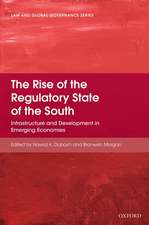Collaborative Environmental Management: What Roles for Government-1
Autor Tomas M. Koontz, Toddi A. Steelman, JoAnn Carmin, Katrina Smith Korfmacher, Cassandra Moseley, Craig W. Thomasen Limba Engleză Paperback – 8 sep 2004
Preț: 331.73 lei
Nou
Puncte Express: 498
Preț estimativ în valută:
63.47€ • 66.45$ • 52.52£
63.47€ • 66.45$ • 52.52£
Carte tipărită la comandă
Livrare economică 05-19 aprilie
Preluare comenzi: 021 569.72.76
Specificații
ISBN-13: 9781891853821
ISBN-10: 1891853821
Pagini: 224
Ilustrații: illustrations
Dimensiuni: 152 x 229 x 15 mm
Greutate: 0.34 kg
Ediția:1
Editura: Taylor & Francis
Colecția Routledge
Locul publicării:Oxford, United Kingdom
ISBN-10: 1891853821
Pagini: 224
Ilustrații: illustrations
Dimensiuni: 152 x 229 x 15 mm
Greutate: 0.34 kg
Ediția:1
Editura: Taylor & Francis
Colecția Routledge
Locul publicării:Oxford, United Kingdom
Public țintă
Academic and Professional Practice & DevelopmentCuprins
Preface AcknowledgmentsAbout the Authors 1. Governmental Roles in Collaborative Environmental Management Part I: Government as Follower2. Citizen-Initiated Collaboration:The Applegate Partnership 3. Nonprofit Facilitation:The Darby Partnership Part II: Government as Encourager4. Encouragement through Carrots and Sticks : Habitat Conservation Planning and the Endangered Species Act 5. Encouragement through Grants: Ohio‘s Farmland Preservation Task Forces Part III: Government as Leader6. Science-Based Collaborative Management: The Albemarle Pamlico Estuarine Study 7. Government-Led Community Collaboration: The Animas River Stakeholder Group Part IV: Reconsidering Governmental Roles8. Government as Actor and as Institution 9. Envisioning the Roles of Government Methodological Appendix Notes References Index
Notă biografică
Tomas M. Koontz is an associate professor of environmental and natural resource policy in the School of Natural Resources at The Ohio State University.Toddi A. Steelman is an assistant professor of environmental and natural resource policy in North Carolina State University's Department of Forestry.JoAnn Carmin is an assistant professor of environmental policy and planning in the Department of Urban Studies and Planning at Massachusetts Institute of Technology.Katrina Smith Korfmacher is Community Outreach Coordinator at the University of Rochester's Environmental Health Sciences Center. Cassandra Moseley is a research associate in the Institute for a Sustainable Environment and an adjunct assistant professor of planning, public, policy and management at the University of Oregon. Craig W. Thomas is an associate professor of political science at the University of Massachusetts, Amherst, where he is also on faculty with the Center for Public Policy and Administration.
Recenzii
'A welcome addition to the growing collaboration literature . . . A useful resource for practitioners and students in environmental policy, planning, and public administration.' Journal of the American Planning Association'A terrific book that expands our understanding of new forms of environmental governance. The authors bring a wealth of experience to provide a balanced, insightful, and highly readable account of a diverse set of cases involving collaboration for natural resource and environmental stewardship.'Peter J. May, University of Washington














